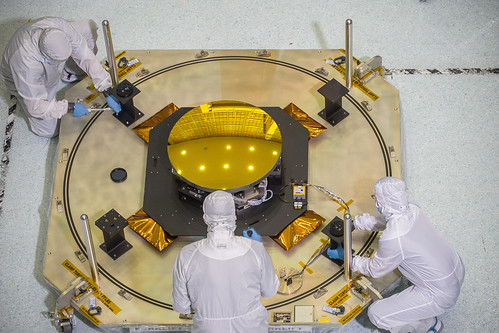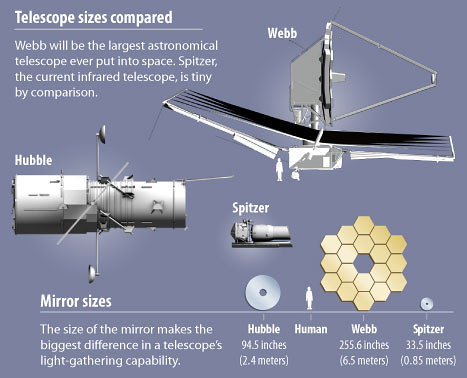A Secondary Space Mirror
- By Maggie Masetti
- April 18, 2014
- Comments Off on A Secondary Space Mirror
One of the cool things about the James Webb Space Telescope’s design is the giant boom that sticks out in front of the telescope. This structure is what holds the telescope’s secondary mirror. It’s the “small” round gold thing, visible in this artist’s conception.

Credit: NASA
Here’s what it looks like for real. This is the flight mirror, the one that is going into space! It’s coated in gold like JWST’s other mirrors to optimize it for reflecting infrared light.

Credit: NASA/Chris Gunn
It’s actually pretty big – in fact it’s not much smaller than the Spitzer Space Telescope’s primary mirror! (Spitzer’s primary mirror is 0.85 meters in diameter, JWST’s secondary mirror is 0.74 meters.) It just looks small next to JWST’s 21 foot diameter primary mirror!

Credit: NASA
Northrop Grumman has the pathfinder, or test version of this boom structure that will hold the secondary mirror.

Credit: Paul Geithner
I found out a little more about it from Deputy Project Manager for JWST, Paul Geithner, and Optical Telescope Element Manager, Lee Feinberg. Here’s their caption for the above photo.
This is the secondary mirror structure (SMSS) for the Pathfinder telescope structure. The flight one will be virtually identical. This image is from a ‘walkout’ of the structure from its stowed to its deployed condition. The scale is evident in the photo, comparing the people and the structure. This walkout involved careful offloading of weight in the 1g environment on Earth; this deployment will take place in space where there is the inertia of the mass but not the weight, and ground deployments require offloading. The flight SMSS is in strength testing, and it will be integrated with the backplane before it is sent to NASA Goddard for telescope assembly.
Before this, the Pathfinder telescope backplane and SMSS will come to Goddard for ‘pathfinding’ operations as practice for the integration we will do on the flight in 2015. Once at Goddard, two spare primary mirror segments and a spare secondary will be installed to make up the Pathfinder telescope.
This is the first time a deployable secondary mirror structure for a space telescope has ever been tested. The SMSS is over 8 meters (26.2 feet) tall.
Here is the Northrop Grumman Integration and Test team after successfully transferring the pathfinder SMSS from the floor assembly jig (that tall, black, latticed structure you see in the other photo) to the backplane pathfinder.

Credit: Northrop Grumman
We’ll be sure to give a report when this huge structure shows up at NASA Goddard – we’ll be excited to see it for ourselves!


